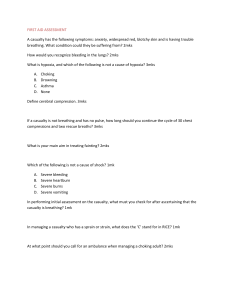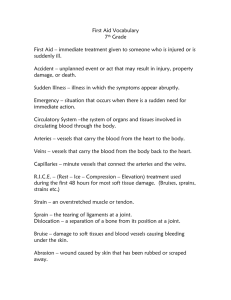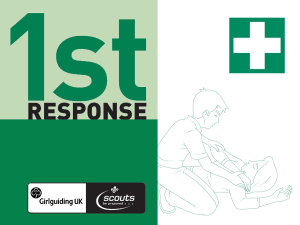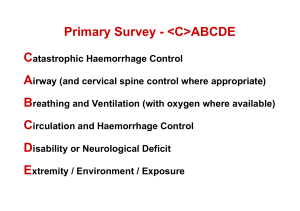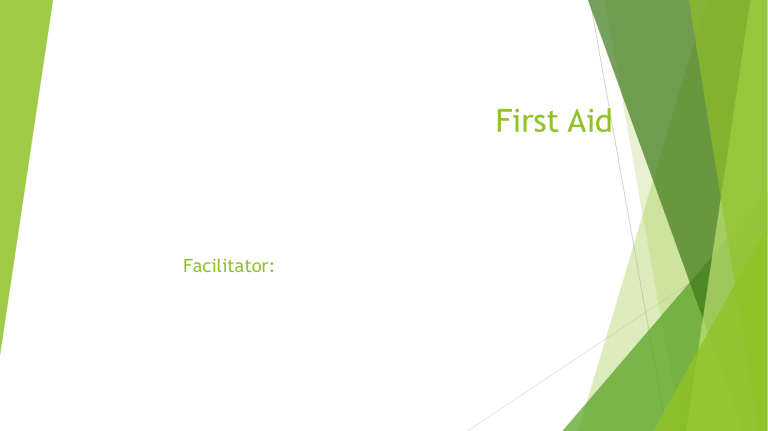
First Aid Facilitator: Introduction Name. Overall experience with emergency incidences. What do you expect to achieve in this course Instructor Expectation • • • • Cooperate with the group. Be open minded to new ideas. Participate actively in all activities. Time conscious Course Logistics • Course agenda • Sign-in sheet • Housekeeping: Cell phone policy Breaks Facilities Other concerns Course Objectives At the end of this part of the course, having passed the assessment, you will be competent in the skills needed to: Manage an Incident in which people are ill or have been injured Take care of them until medical help is available. Recognizing the Task of a First Aider What is First Aid? The initial help given to a casualty using available materials and generally accepted principles of treatment before handing over to a more responsible person. Aims /Why? Preserve Prevent /save life the condition from getting worse Promote recovery How prepared are you incase of an emergency at home? EMERGENCY RESPONSE PLAN Do you have any emergency contact on your phone or displayed anywhere in the house or building? Do you have a preferred hospital or clinic to go to incase of an emergency? Incase you don’t find you guardian, employer, employee on phone, how do you handle an emergency? Tatu city has an emergency response team on standby. Incident management Assess the situation Make the Area Safe Emergency aid Get Help Aftermath 4WCT PHONE CALL CONTENTS 1. 2. 3. 4. 5. 6. Who Why Where What Confirmation Time HOSP CASUALTY MANAGEMENT INITIAL ASSESMENT LIFE THREATENING PRIORITIES AIRWAY BREATHING CIRCULATION What your tongue could do.. Obstructed Airway Open Airway The Primary Survey Danger Response Shout for help Airway Breathing Circulation Secondary survey (assessment for other injuries/medical conditions) This includes the following: Head-to-toe survey History External clues Recognition features: Signs & symptoms The Unconscious Casualty Aim : Is To Maintain An Open Airway Management: Turn To Recovery Position CASUALTY MANAGEMENT-BREATHING Danger Response SHOUT for Help Airway Breathing-PRESENT Circulation Secondary SURVEY RECOVERY POSITION CALL/SEND/GO FOR HELP) Cardio-Pulmonary Resuscitation(CPR) CARDIO PULMONARY RESCUSCITATION (cpr) If casualty is not breathing or if you have any doubt whether breathing is normal begin CPR CPR entails giving air and pumping blood with your hands in order to sustain a casualty. I.E. • Chest compressions • Artificial ventilations (Continued) 30 Chest Compressions ADULT CHILD 1 – Puberty) INFANT (Below 1 year) Danger CPR: SUMMARY Response Shout for help Airway (open) Breathing (absent)send 4 help now For a child/infant give first 5 breaths Chest compressions -30 Artificial ventilations– 2 Keep repeating 30 compressions and 2 ventilations till…… Help comes Casualty recovers Too exhausted to carry on The scene is no longer safe On physicians orders If you are alone, perform around 5 cycles of resuscitation first before going for help yourself. Disorders of Airway & Breathing Choking Partial or complete obstruction of the airway by a foreign body Choking: Treatment of an Adult or Child Encourage them to continue coughing. Give up to 5 back blows Give up to 5 abdominal thrusts Alternate blows with thrusts BACK BLOWS Abdominal thrusts Choking: Treatment of an Infant Give up to 5 back blows Give up to 5 chest thrusts Choking expectant Give chest thrusts till obstruction clears or becomes unconscious Anaphylactic Shock Massive allergic reaction that may take minutes or seconds after exposure to particular allergen. Causes: Sting from an insect or plant Foods Contact/inhalation of substances Drugs Recognition features Difficulty in breathing Wheezing sound Cyanosis Swelling of face, neck, tongue,…. Puffiness around eyes Tightness around chest Rashes (Continued) Anaphylactic shock management DR.ABC-send for help Encourage to sit in a comfortable position to ease breathing If unconscious…. Turn to recovery position or begin CPR Anaphylaxis is a true emergency and it affects susceptible individuals ,medical aid is urgently required if suspected Anaphylaxis pre-hospital auto-injector Epinephrine/Adrenaline Disorders of Circulation Fainting Brief loss of consciousness due to inadequate oxygen/blood supply to the brain Causes of fainting Sudden news Hunger Exhaustion Standing for a long time Early stages in pregnancy Recognition features Sudden collapse History Shallow breathing Slow pulse Sweating Fainting: Treatment Aim: to improve blood supply to the brain Action DR.ABC-loose tight clothing Lay casualty flat on back and elevate his legs Shock Insufficient blood (oxygen)supply to vital body organs Causes: 1. Reduction in blood(fluid) volume Severe bleeding: internal/external Severe burns Severe dehydration due to vomiting, sweating, diarrhoea (Continued) Shock: Recognition Pale ,cold and sweaty skin Dizziness Fast, and nausea shallow breathing Rapid, weak pulse Cyanosis: blueness of extremities Thirst Progressively deteriorating level of response Shock management DR.ABC-send for help Lay the casualty down, raise and support their legs. Cover to keep them warm and reassure If uncons…turn to recovery position Monitor breathing and pulse frequently. (Continued) Shock : Treatment Position Dressings & Bandages Dressing Cover for wounds(sterile) to: Control bleeding • Prevent against infection • To protect from further injury • Types: gauze, standard sterile, adhesive, improvised.. (Continued) Dressing… If blood seeps through the dressing, apply another on top. If it seeps through the 2nd, remove both and tie a new one. Bandage Support for dressings or limbs (not necessarily sterile) to: • Immobilize limbs • hold dressings in place • reduce swelling • control bleeding Types: gauze roller, crepe, plaster, triangular…… BLEEDING Types of bleeding Internal bleeding External bleeding Internal Bleeding May present with signs of shock without apparent visible blood loss (concealed) e.G. From liver, spleen… A bruise May cause bleeding through the natural body orifices depending on actual source of the bleeding e.g. Via nose, urethra… Priority is to recognize / minimize shock and get urgent medical aid. Orifice Appearance of blood Mouth •fresh bright red •coughed up frothy •vomited brown Nose •fresh bright red •thin watery Earsrs •fresh bright red •thin watery Urethra •fresh bright red •smoky looking urine Anus Vagina •mouth, tongue, knocked out tooth •lungs •stomach •ruptured nose blood vessels •skull fracture •inner or outer ear •skull fracture •urethra •urethra •kidneys/bladder •fresh bright red •dark with offensive smell •fresh or dark Indication •lower bowels/anus/piles •upper bowels •abortion,miscarriage,menstruati on, injury or disease to vagina/womb Internal bleeding ….mngt Nose bleeding Is mostly caused by rupture of tiny blood vessels inside the nostrils. Causes: a blow to the nose, sneezing, picking or blowing the nose, high blood pressure, temperature changes………. If the blood is thin and watery it may indicate a skull fracture Advise casualty to sit down leaning forward Pinch soft part of the nose and to release the pressure after every 10minutes. Once the bleeding stops clean around their nose with lukewarm water. Nose bleeding… Advise them not to speak, swallow, cough, spit or sniff because this may disturb blood clots Do not let the head tip back; blood may run down the throat inducing vomiting. Types of Wounds Contusion/bruise - blunt blow Laceration/tear – barbed wire Incision/clean cut - sharp edge Puncture/stab - sharp point Graze/abrasion - friction/sliding fall Gunshot - bullet BLEEDING EXTERNAL- CLASSIFIED ACCORDING TO BLOOD VESSEL THAT IS DAMAGED: ARTERIAL BLEEDING VENOUS BLEEDING CAPILLARY BLEEDING External Bleeding A. Minor Bleeding Priority Is To Minimize The Risk Of Infection B. Severe Bleeding Priority To Control Bleeding, Minimize Shock And Get Help. Minor bleeding Put On Disposable Gloves. Clean The Cut Under Running Water And Dry It Cover The Cut Completely With A Sterile Dressing. Advice To Seek Anti-tetanus Treatment Severe Bleeding Expose eXamine Pressure Elevate Cover Treat for shock Musculoskeletal Injuries Sprains & Strains Sprain: tearing or overstretching of ligaments Strain: overstretching and tearing of a tendon Management Rest Ice Comfort /Compress Elevate Soft tissue injuries: Muscle Cramps/pulls Involuntary and painful muscular contractions. Caused by poor oxygenation & accumulation of waste (lactic acid)– vigorous activity or cold Management A soft massage and stretching the cramped muscle, Applying heat improves superficial blood circulation and makes muscles more flexible Poisoning Poisons A POISON/TOXIN - any substance which, if taken into the body in sufficient quantity, may cause temporary or permanent damage. Methods of poisoning Ingestion (swallowing) Absorption through the skin Inhalation Splashing/ instillation into the eyes Injected. Swallowed Poisons DR.ABC-send for help and reassure If non-corrosive poison give nothing to eat or drink DO NOT induce vomiting DO NOT try to neutralize/ dilute the poison (Continued) Swallowed poisons contd…. If corrosive poison, give frequent sips of cold water If unconscious place in recovery position, monitor R.ABC and be prepared to resuscitate If possible identify the container that held the poison and carry it to hospital Inhaled poisons Remove casualty to open air without endangering yourself R.ABC –send for help If unconscious turn to recovery position or give CPR. Skin contact DO NOT touch the affected area with your bare hands Wash away the poison with cold water. Avoid splashing onto yourself or into the casualties eyes, mouth or nose If chemical is causing burns, flush for 20mins Remove all contaminated clothing Splashing into the eye Irrigate the affected eye with water Cover with an eye pad Bites & Stings Insect Stings Reassure and calm the casualty down. If visible, carefully remove the sting. Apply an ice pack or for at least 10mins. If swelling and pain persist advise the casualty to see their doctor. (Continued) Animal Bites Wash the wound with soap and water Cover with a sterile dressing If bleeding severely apply EXPECT procedure instead Take to hospital Snake Bites Snake Bites Most snakes are not poisonous but snake bites usually cause a lot of anxiety and distress to the casualty. Aims Ensure safety – no more bites Identify the snake Control distribution of venom in the body Get medical aid ASAP. Snake Bite: Treatment Rest, calm and reassure the casualty to slow down the heart rate Lay him with the heart higher than the bite, wash the bite with soap and water Use a roller bandage to tie a spiral bandage above the bite Get help (Continued) Snake Bite management… DO NOT use a tourniquet or a constricting bandage DO NOT cut the wound DO NOT attempt to suck out the venom Lifting and carrying Factors to consider: Distance Weight Nature of injuries/condition Number of helpers Terrain/location Guidelines Keep back in locked in position Flex at hips, not the waist Bend at the knees Lift without twisting Have feet positioned properly Communicate with partner/s Keep weight close to the body Methods One helper: Drag Pick a back (piggy back) Cradle Fire man’s lift Human crutch 2 helpers 2 handed seat 4 handed seat More helpers Blanket lift Stretcher Spine board Questions?


